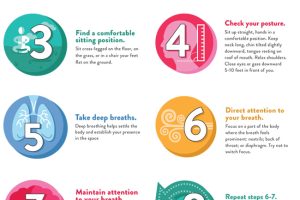Mindfulness Techniques for a Balanced Life

Introduction to Mindfulness Techniques
What is Mindfulness?
Mindfulness is the art of paying attention to the present moment without judgment. It invites individuals to experience their thoughts, feelings, and sensations as they happen. This practice, rooted in ancient meditation traditions, encourages one to observe these elements just as they are—fostering self-awareness and a deeper connection to the here and now. For example, during a mindful walk, one might notice the sensation of the ground beneath their feet or the way the wind gently rustles the leaves.
- Mindfulness Techniques for a Balanced Life
- Introduction to Mindfulness Techniques
- What is Mindfulness?
- Benefits of Practicing Mindfulness
- Mindfulness Meditation
- Step-by-Step Guide to Mindfulness Meditation
- Mindfulness Meditation Techniques
- Mindful Breathing Exercises
- Deep Breathing Technique
- Box Breathing Exercise
- Body Scan Meditation
- Understanding Body Scan Meditation
- How to Practice Body Scan Meditation
- Mindful Movement Practices
- Yoga for Mindfulness
- Walking Meditation
- Mindful Eating
- Benefits of Mindful Eating
- Tips for Practicing Mindful Eating
- Mindfulness in Daily Activities
- Bringing Mindfulness to Daily Routine
- Mindful Communication Techniques
- Gratitude and Mindfulness
- Cultivating Gratitude through Mindfulness
- Gratitude Journal Prompts
- Mindfulness for Stress Reduction
- Stress Management through Mindfulness
- Mindfulness-Based Stress Reduction Techniques
- Mindfulness for Emotional Regulation
- Understanding Emotions through Mindfulness
- Coping Strategies with Mindfulness Techniques
Benefits of Practicing Mindfulness
The advantages of incorporating mindfulness techniques into daily life are numerous:
- Reduced Stress: By acknowledging thoughts without being consumed by them, stress levels often decrease.
- Enhanced Focus: A mindful approach cultivates concentration, making it easier to stay present with tasks at hand.
- Improved Emotional Health: Regular practice can lead to lower levels of anxiety and depression.
- Increased Resilience: Mindfulness encourages a proactive mindset, helping individuals better cope with challenges.
Many find that integrating even a few moments of mindfulness each day can profoundly enhance their overall well-being.
Mindfulness Meditation
Step-by-Step Guide to Mindfulness Meditation
Mindfulness meditation is a practice that encourages one to connect deeply with the present. Getting started can be simple and effective. Here’s a step-by-step guide:
- Find a Comfortable Position: Sit in a chair or on the floor—whatever feels most natural to you.
- Close Your Eyes: This helps minimize distractions and turn your focus inward.
- Take Deep Breaths: Inhale deeply through your nose, hold for a moment, and exhale slowly through your mouth.
- Focus on Your Breath: Notice the sensation of each breath as it enters and exits your body. If your mind wanders, gently bring it back to your breath.
This method allows you to cultivate awareness without judgment, leading to a more tranquil mindset.
Mindfulness Meditation Techniques
There are various techniques to enhance your mindfulness practice:
- Guided Meditations: Listen to recordings that guide you through a mindfulness session.
- Zen Meditation (Zazen): Focus on sitting with no movement, paying close attention to breath and posture.
- Loving-kindness Meditation: Cultivate feelings of compassion and love for yourself and others.
For example, during a recent mindfulness session, I found that practicing loving-kindness meditation helped improve my empathy towards peers, enhancing my relationships. Integrating these techniques can enrich your mindfulness journey and help deepen your understanding of self.
Mindful Breathing Exercises
Deep Breathing Technique
Breath is our constant companion, yet many of us overlook its power. The deep breathing technique is a simple and effective way to ground yourself in moments of stress or anxiety. Here’s how to practice it:
- Find a Quiet Space: Sit or lie down comfortably.
- Inhale Slowly: Breathe in deeply through your nose for a count of four.
- Hold Your Breath: Pause for a moment, holding the breath for another count of four.
- Exhale Gently: Release the breath through your mouth for a count of six.
- Repeat: Continue this cycle for a few minutes.
I once used this technique before a big presentation, and it helped soothe my nerves, allowing me to speak more clearly and confidently.
Box Breathing Exercise
Box breathing is another effective mindful exercise that helps to stabilize your emotions and calm your mind:
- Inhale for Four Counts: Breathe in deeply through your nose.
- Hold for Four Counts: Keep your breath held.
- Exhale for Four Counts: Slowly breathe out through your mouth.
- Hold for Four Counts: Pause again before inhaling.
This structured pattern creates a “box” effect with your breath, promoting relaxation. It’s a favorite of many, including athletes and military personnel, for enhancing focus and reducing stress, making it an excellent addition to your mindfulness toolkit.
Body Scan Meditation
Understanding Body Scan Meditation
Body scan meditation is a powerful technique that allows you to connect with your physical self and cultivate awareness of your body’s sensations. By focusing on different parts of the body, you can release tension and promote relaxation. This practice not only heightens self-awareness but also fosters a deeper appreciation of the body’s sensations, helping to bridge the gap between mind and body. Many people, including myself, find that practicing body scan meditation can reveal areas of stress or discomfort that might go unnoticed in daily life, leading to more intentional self-care.
How to Practice Body Scan Meditation
To get started, follow this simple outline:
- Find a Comfortable Position: Lie on your back with your arms at your sides.
- Close Your Eyes: This helps minimize distractions and enhances focus.
- Begin with Deep Breaths: Inhale deeply, then exhale to settle into the moment.
- Focus on Each Body Part: Starting from your toes, gradually shift your attention upwards, spending a few moments on each area. Notice any sensations or feelings.
- Release Tension: As you focus, consciously relax any areas of tightness or discomfort.
- Take Your Time: Allow 15-30 minutes for the practice, ensuring you give yourself enough time to connect with your body.
Incorporating regular body scan meditation into your routine can create a profound sense of relaxation and body awareness, helping to elevate your overall mindfulness practice.
Mindful Movement Practices
Yoga for Mindfulness
Yoga is a fantastic way to cultivate mindfulness through physical movement. By integrating breath with movement, practitioners can enhance their awareness of both body and mind. When practicing yoga, you focus on each pose, allowing your thoughts to settle, and encouraging a deep sense of presence. Common techniques include:
- Mindful Breathing: Sync your breath with each movement, inhaling deeply as you rise into a pose and exhaling as you transition.
- Restorative Poses: Incorporate gentle stretches such as Child’s Pose or Legs-Up-The-Wall, which promote relaxation and self-reflection.
During my first yoga class, I noticed how each pose helped quiet my thoughts, grounding me in the present moment.
Walking Meditation
Walking meditation brings mindfulness into motion, allowing one to become aware of their surroundings and bodily sensations while moving. Here’s how to get started:
- Choose a Quiet Space: Find a serene environment, such as a park or your backyard.
- Walk Slowly: Take deliberate steps, focusing on the sensation of your feet touching the ground.
- Breathe Naturally: Keep your breath relaxed and notice how it coordinates with your movements.
- Engage Your Senses: Pay attention to the sights, sounds, and smells around you to deepen your experience.
Integrating walking meditation into your routine can transform a simple stroll into a profound practice of mindfulness, enriching your connection to the world around you.
Mindful Eating
Benefits of Mindful Eating
Mindful eating is an engaging practice that revolves around fully experiencing and appreciating each bite of food. This approach brings numerous benefits, transforming mealtime into an intentional and reflective experience. Some key advantages include:
- Better Digestion: When you eat slowly and chew thoroughly, you’re helping your body digest food more effectively.
- Weight Management: By paying attention to hunger and satiety cues, individuals often eat less and enjoy food more.
- Enhanced Pleasure in Eating: Mindful eating encourages appreciation for flavors and textures, making meals more enjoyable.
- Emotional Awareness: This practice allows for reflection on cravings and emotional triggers tied to eating habits.
I’ve found that slowing down during meals makes me savor every bite, turning ordinary meals into small celebrations.
Tips for Practicing Mindful Eating
To incorporate mindful eating into your routine, consider these practical tips:
- Eliminate Distractions: Set aside time to eat without the TV or phone.
- Engage Your Senses: Notice the colors, smells, and textures of your food before taking a bite.
- Chew Slowly: Aim to chew each bite at least 20 times; this helps you enjoy flavors fully.
- Listen to Your Body: Pay attention to hunger signals and stop eating when satisfied, not stuffed.
- Practice Gratitude: Take a moment to express gratitude for your food and where it comes from.
By implementing these strategies, meals can transition from a hurried experience to a fulfilling and mindful practice, nurturing a deeper relationship with food.
Mindfulness in Daily Activities
Bringing Mindfulness to Daily Routine
Incorporating mindfulness into daily activities can elevate mundane tasks into moments of awareness and appreciation. Whether it’s washing the dishes or commuting to work, these practices can transform how you experience everyday life. Here are some simple ways to make your routine more mindful:
- Morning Rituals: Start your day with a few minutes of mindfulness, focusing on your breath or setting intentions for the day.
- Mindful Commuting: If you take public transport, use travel time to engage in mindful breathing or listen to soothing music, rather than scrolling through newsfeeds.
- Engagement in Menial Tasks: When doing chores, fully immerse yourself in the sensations—feel the warmth of the water while washing dishes, or notice the movement of your body while sweeping.
I often find that when I practice mindfulness during my routine tasks, I feel more grounded and less overwhelmed by the day’s chaos.
Mindful Communication Techniques
Effective communication is another area where mindfulness can make a significant difference. To communicate mindfully, consider these techniques:
- Active Listening: Fully give your attention when someone is speaking, avoiding interruptions. This builds stronger connections.
- Pause Before Responding: Take a moment to reflect on your response rather than reacting impulsively.
- Use “I” Statements: Express feelings and thoughts using “I” statements to promote understanding and reduce defensiveness (e.g., “I feel…” instead of “You always…”).
- Nonverbal Awareness: Pay attention to your body language and tone. A welcoming smile or calm voice can enhance your message.
Bringing mindfulness into communication has enriched my relationships, fostering deeper connections based on understanding and respect. By integrating these techniques, daily interactions can become more meaningful and positively transformative.
Gratitude and Mindfulness
Cultivating Gratitude through Mindfulness
Gratitude and mindfulness have a powerful synergy that can lead to enhanced well-being and a more positive outlook on life. By practicing mindfulness, individuals can become more attuned to the small blessings in their daily lives. Taking a moment to appreciate the present allows one to recognize the abundance that surrounds them. For example, during a mindful walk, I often find myself appreciating the warmth of sunshine or the beauty of blooming flowers. This heightened awareness fosters a deep sense of gratitude, making me feel more connected to my environment and less focused on what I lack.
Gratitude Journal Prompts
One effective way to cultivate and express gratitude is through journaling. Here are some prompts to inspire your gratitude practice:
- What made you smile today?
- Describe a challenging experience that ultimately taught you something valuable.
- List three things you appreciate about your home.
- Who in your life are you grateful for, and why?
- What is a simple pleasure you often overlook?
By regularly engaging with these prompts, you allow moments of gratitude to flourish, integrating mindfulness naturally into your routine. This practice not only enhances overall well-being but also nurtures a more positive mindset as you develop a deeper appreciation for everyday experiences.
Mindfulness for Stress Reduction
Stress Management through Mindfulness
Mindfulness offers powerful tools for managing stress that can be easily integrated into daily life. By focusing on the present moment, mindfulness interrupts the cycle of stress-driven thoughts and allows individuals to respond to challenges with clarity and calmness. For instance, I’ve personally found that a few minutes of mindful breathing can instantly reduce my anxiety, especially when I’m feeling overwhelmed at work. This allows me to regroup and approach tasks with a clearer mind. Some common stress management techniques include:
- Dedicating Time for Reflection: Carve out a few minutes daily to sit quietly and observe thoughts without judgment.
- Prioritizing Self-Care: Engage in activities that rejuvenate you, whether it’s reading, exercising, or connecting with nature.
Mindfulness-Based Stress Reduction Techniques
One highly effective approach specifically designed for stress reduction is the Mindfulness-Based Stress Reduction (MBSR) program, which incorporates several techniques:
- Body Scan Meditation: As discussed earlier, this practice involves focusing on different parts of your body to release tension.
- Mindful Breathing: Utilize the deep breathing and box breathing exercises to center yourself during stressful moments.
- Gentle Yoga: Integrating mindful movements can enhance relaxation and promote physical well-being.
- Guided Imagery: Visualization can help transport your mind to a peaceful place, reducing anxiety and stress.
By employing these MBSR techniques, individuals can significantly alleviate stress, fostering resilience and enhancing overall emotional health. This intentional practice empowers you to face life’s challenges with a composed and mindful approach.
Mindfulness for Emotional Regulation
Understanding Emotions through Mindfulness
Mindfulness serves as a powerful tool for understanding and regulating emotions. By observing emotions without immediate reaction, individuals can gain insight into their emotional responses. This level of awareness helps to differentiate between a fleeting feeling and a deeper-rooted issue. For example, on days when I’ve felt overwhelmed or irritable, taking a few moments to practice mindfulness has allowed me to identify the root causes of my emotions, rather than simply reacting to them. This practice not only cultivates self-awareness but also fosters compassion for oneself during difficult times.
Coping Strategies with Mindfulness Techniques
To effectively manage emotions through mindfulness, consider these coping strategies:
- Label Your Emotions: When you experience a strong emotion, try to label it. Acknowledging that you feel “anxious” or “frustrated” can help create distance from the feeling.
- Practice Self-Compassion: Treat yourself with kindness when emotions arise, as if you were comforting a friend.
- Engage in Mindful Journaling: Write about your emotions without judgment, reflecting on possible triggers and responses.
- Employ Breathing Techniques: When emotions become overwhelming, return to mindful breathing to regain calm.
These techniques enable individuals to approach emotional experiences thoughtfully rather than reactively, ultimately leading to healthier emotional regulation and enhanced resilience in the face of life’s challenges.




